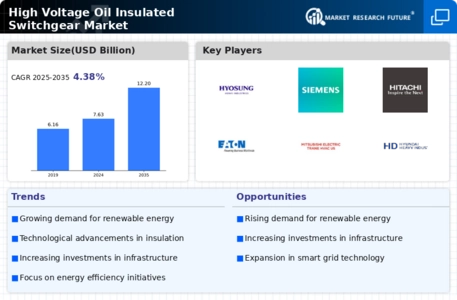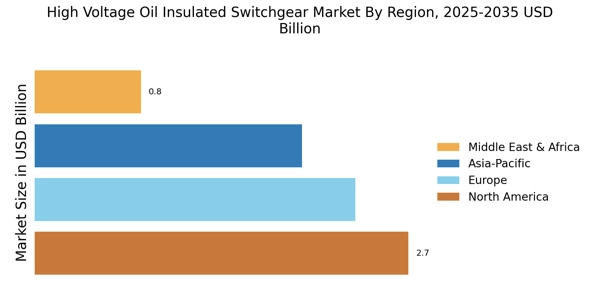Rising Demand for Renewable Energy
The increasing emphasis on renewable energy sources is driving the High Voltage Oil Insulated Switchgear Market. As countries strive to meet their energy needs sustainably, the integration of renewable energy into existing grids necessitates robust switchgear solutions. The International Energy Agency indicates that renewable energy capacity is expected to grow significantly, leading to a heightened demand for high voltage switchgear that can handle variable loads and ensure reliability. This trend is likely to propel investments in high voltage oil insulated switchgear, as utilities seek to modernize their infrastructure to accommodate cleaner energy sources.
Government Regulations and Standards
Government regulations and standards are shaping the High Voltage Oil Insulated Switchgear Market. Many countries are implementing stringent regulations aimed at enhancing the safety and efficiency of electrical systems. Compliance with these regulations often requires the adoption of advanced switchgear technologies. For instance, the International Electrotechnical Commission has established standards that promote the use of oil insulated switchgear due to its reliability and performance. This regulatory landscape is likely to drive manufacturers to innovate and upgrade their offerings, thereby expanding the market.
Growing Urbanization and Industrialization
Urbanization and industrialization are pivotal factors influencing the High Voltage Oil Insulated Switchgear Market. As populations migrate to urban areas, the demand for electricity surges, necessitating the expansion of electrical infrastructure. According to the United Nations, urban areas are projected to house 68% of the world population by 2050, which will likely increase the need for reliable power distribution systems. High voltage oil insulated switchgear plays a crucial role in ensuring that urban centers receive uninterrupted power supply, thereby supporting economic growth and development.
Increased Investment in Power Infrastructure
Increased investment in power infrastructure is a key driver of the High Voltage Oil Insulated Switchgear Market. Governments and private entities are allocating substantial funds to upgrade aging electrical grids and expand capacity to meet rising energy demands. According to the World Bank, investments in energy infrastructure are projected to reach trillions of dollars over the next decade. This influx of capital is likely to stimulate the demand for high voltage oil insulated switchgear, as it is essential for ensuring the reliability and safety of modern power systems.
Technological Innovations in Switchgear Design
Technological innovations are transforming the High Voltage Oil Insulated Switchgear Market. Advances in materials science and engineering have led to the development of more efficient and durable switchgear solutions. Innovations such as smart grid technologies and automation are enhancing the functionality of high voltage oil insulated switchgear, making it more adaptable to modern energy demands. The market is witnessing a shift towards digitalization, where integrated monitoring systems provide real-time data, improving operational efficiency. This trend is expected to attract investments and drive growth in the sector.


















Leave a Comment